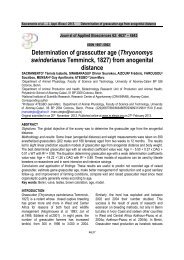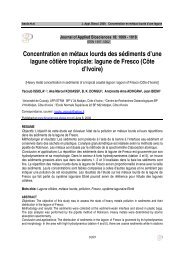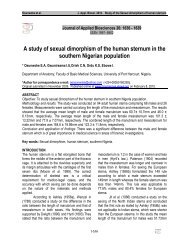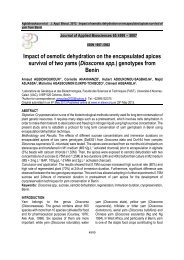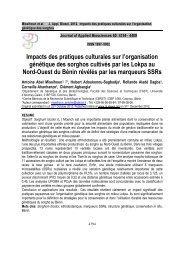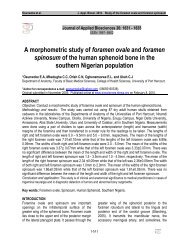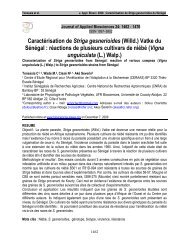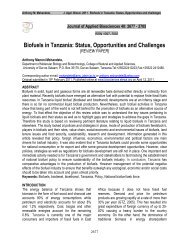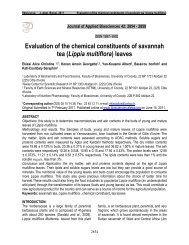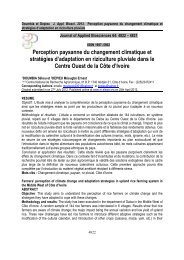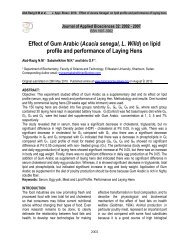Pratiques d'utilisation et de gestion des pesticides par les ...
Pratiques d'utilisation et de gestion des pesticides par les ...
Pratiques d'utilisation et de gestion des pesticides par les ...
- No tags were found...
Create successful ePaper yourself
Turn your PDF publications into a flip-book with our unique Google optimized e-Paper software.
Doumbia & Kwadjo……………………...……………J. Appl. Biosci. 2009. <strong>Pratiques</strong> d’utilisation <strong>et</strong> <strong>gestion</strong> pestici<strong>de</strong>s100% <strong>de</strong> maraîchers806040200AbidjanBanlieuesDépôt sur le site Enfouissement Vente UsageFigure 9 : Mo<strong>de</strong> <strong>de</strong> <strong>gestion</strong> <strong>de</strong>s emballages <strong>par</strong> <strong>les</strong> maraîchers.90% <strong>de</strong> maraîchers80706050403020100AbidjanBanlieuesAucune protection Protection minimale Combinaison complèteFigure 10 : Ré<strong>par</strong>tition <strong>de</strong>s maraîchers selon <strong>les</strong> mesures <strong>de</strong> protection lors <strong>de</strong>s traitements phytosanitairesLes principaux arguments avancés pour justifier c<strong>et</strong>te"non protection" sont : l'absence <strong>de</strong> risque pourl'applicateur, la difficulté pratique <strong>de</strong> changer <strong>de</strong>vêtements après la pulvérisation, le manque <strong>de</strong> confortau travail, la maîtrise <strong>de</strong> la direction du vent.Néanmoins, quelques uns se munissent d’unou <strong>de</strong> plusieurs <strong>de</strong>s éléments suivants : gants, cachenez(masque à nez ou étoffe <strong>de</strong> tissu), bottes, habitsspéciaux. Tous <strong>les</strong> producteurs affirment se laver <strong>les</strong>mains <strong>et</strong> le visage après l’épandage <strong>de</strong> produits.L’application <strong>de</strong> pestici<strong>de</strong>s se fait tôt le matin, entre 6 <strong>et</strong>9 heures.L’AFC en rapport avec la perception environnementale<strong>de</strong>s maraîchers fait ap<strong>par</strong>aître 3 types <strong>de</strong> producteurs<strong>de</strong> cultures maraîchères (figure 11). L’axe 1 d’inertie58,70% révèle <strong>les</strong> producteurs du type I (d’AttécoubéBanco <strong>et</strong> d’Anyama) qui conservent <strong>les</strong> produitsphytosanitaires dans leur domicile en attendant qu’ilssoient utilisés. En outre, ils ont l’habitu<strong>de</strong> d’enfouir <strong>les</strong>emballages <strong>de</strong> pestici<strong>de</strong>s sur le site <strong>de</strong> production,après l’épandage <strong>de</strong>s produits. L’axe 2 d’inertie 30,16%différencie <strong>les</strong> maraîchers du type II (<strong>de</strong> Port-Bouët43 ème Bima) qui achètent <strong>les</strong> pestici<strong>de</strong>s <strong>et</strong> <strong>les</strong> utilisentimmédiatement, <strong>de</strong> ceux qui gar<strong>de</strong>nt <strong>les</strong> produits998



